Toshiba Satellite A660D-ST2G01: AMD's Quad-Core Phenom II P920 Joins the Mobile Party
by Jarred Walton on August 31, 2010 12:45 AM ESTToshiba A660D-ST2G01 General Performance
As one of the first up-to-date AMD notebooks to hit our labs in a long time, the Toshiba A660D certainly piqued our interest. Where will the quad-core P920 fall in regards to the competition? How much will battery life improve? How does gaming fare? You've got questions, and we've got the answers. Here's a recap of the pertinent details of our test system.
| Toshiba A660D-ST2G01 Test System | |
| Processor |
AMD Phenom II P920 (4x1.6GHz, 45nm, 4x512KB L2, 25W) |
| Chipset | AMD RS880M Northbridge, AMD SB850 Southbridge |
| Memory | 2x2GB DDR3-1066 (Max 2x4GB) |
| Graphics |
ATI Mobility Radeon HD 4250 (40 Stream Processors, 500MHz Core, Integrated) ATI Mobility Radeon HD 5650 (400 Stream Processors, 450MHz Core, 1600MHz GDDR3) |
| Display |
16" LED Glossy 16:9 768p (1366x768) Samsung 160AT06-U01 |
| Hard Drive(s) | Toshiba 500GB 7200 RPM Hard Disk |
| Optical Drive | DVD+/-RW Combo Drive with LabelFlash |
| Battery | 6-Cell, 10.8V, 48Wh battery |
| Operating System | Windows 7 Home Premium 64-bit |
| Pricing |
Starting at $949 Online A665D-S6059: $800 Online |
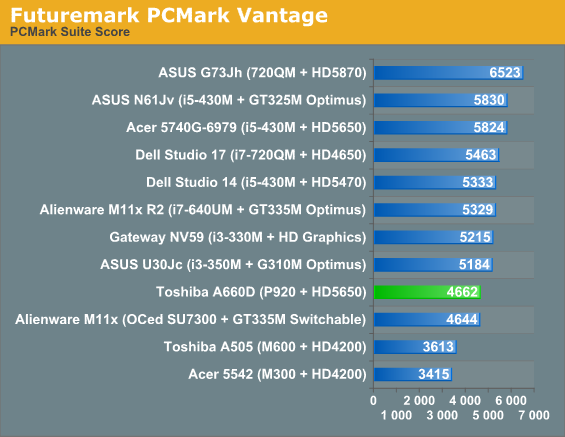
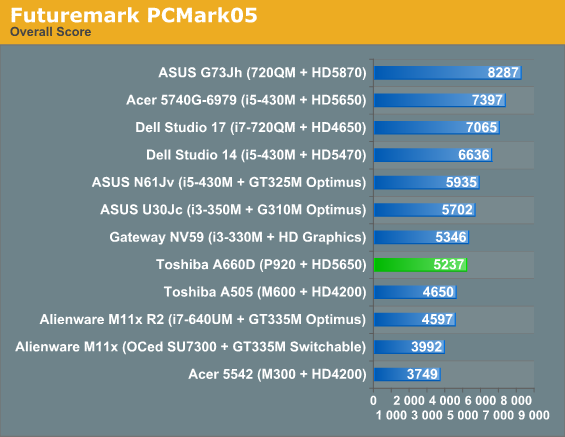
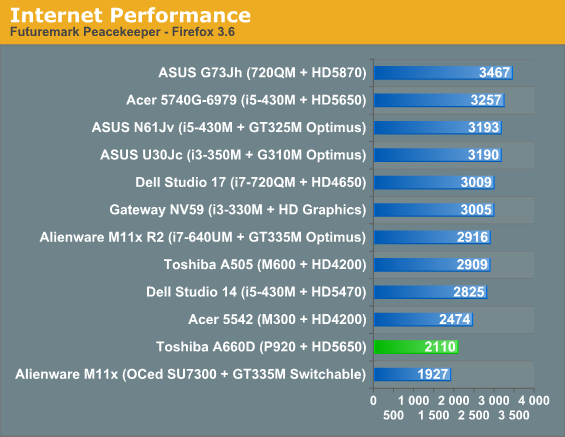
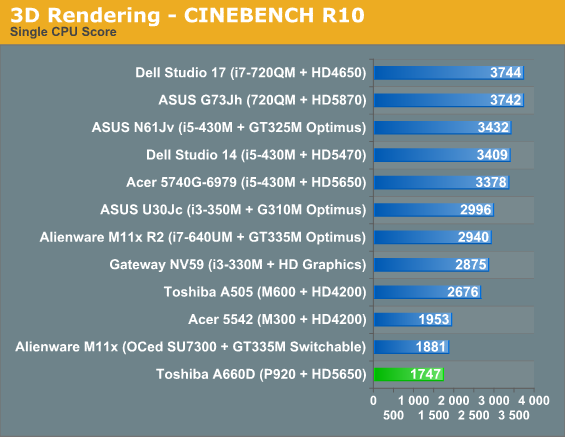
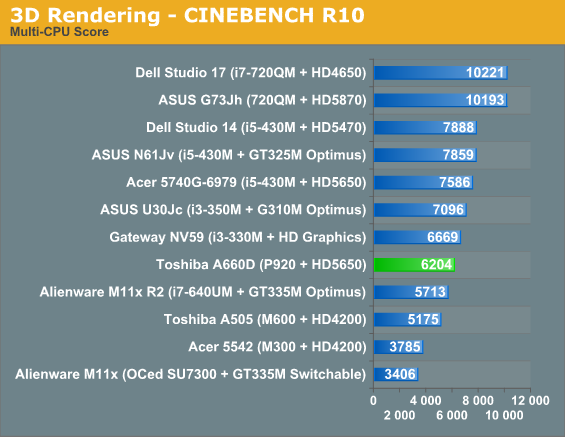

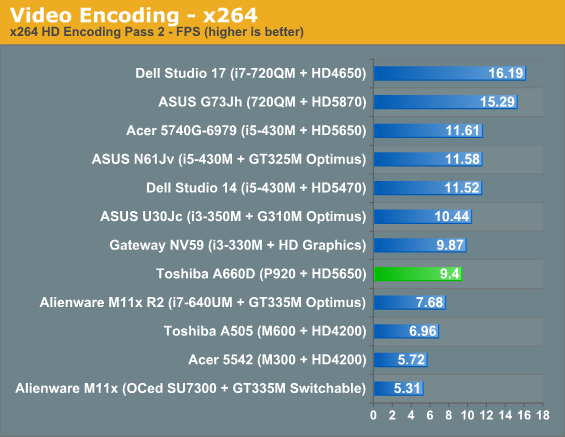
Starting off with PCMark Vantage and PCMark05, we get our first glimpse of the potential of the P920. Despite the lower clock speed, the P920 outpaces the Turion II M600 by 20% and the Athlon II M300 by 27% in Vantage. The gap is smaller in PCMark05, but that's obviously an old (outdated even) benchmark so we won't worry about it too much. That's the good news; the bad news is that Intel's slowest Core i3 processors are still faster in general application performance. The i3-330M with Intel HD Graphics is 20% faster, and the i5-430M with HD 5650 is 34% faster. The slow clock speed of the P920 just doesn't keep up in these types of workloads.
Peacekeeper shows the worst-case scenario where Intel's Turbo Boost is in full effect and the higher clocks of dual-core parts take front stage. On the AMD side, the M300 is 17% faster than the P920 and the M600 is 38% faster. Switch to Intel and the slowest i3-330M comes in 42% faster (ouch!), while the i5-430M is 54% faster. Heavily threaded tests don't do the P920 any favors either, as the i3-330M with Hyper-Threading still leads by a small amount in Cinebench SMP and x264 2nd pass. The only win for the P920 comes in the first pass of x264 encoding, where it's about 5% faster than the i3-330M.
What about the AMD quad-core versus Intel quad-core comparison? The ASUS G73Jh does come with a faster 5870 GPU, but even when we take that out of the picture the i7-720QM is clearly much faster than the P920. The gap is 50% in PCMark Vantage, and it goes up from there. The lead is 64% in Peacekeeper and 114% in the single-threaded Cinebench result, where Turbo Boost is in full effect. The lead in multi-core Cinebench is 64%, 2nd pass x264 is 63%, and the closest result is in the 1st pass x264 where the lead drops to just 19% (as memory and storage performance become bigger factors).
The P920 is certainly fast enough for most users, but the fact that a quad-core processor can't establish a lead over dual-core Intel parts even in multi-threaded tests is telling. Low power draws are good for battery life, but higher clock speeds are necessary to close the performance gap. We'd really like to see AMD put their Turbo Core technology from the desktop Phenom II X6 processors into their mobile parts, as the low 1.6GHz clock is definitely hurting performance in many tasks. In fact, there are a few instances where the overclocked SU7300 CULV processor (in the Alienware M11x) beats the P920. AMD does have some faster quad-core parts available, of course. N930 runs at 2.0GHz, which means it should be around 25% faster in CPU limited tasks, and the X920 BE runs at 2.30GHz, but those comes with 35W and 45 TDP, respectively. At lower loads those processors should use roughly the same power as the P920, but load power draw will be substantially higher.
The bottom line is that AMD's CPU cores could still use help, as clock for clock they're similar to the old Core 2 chips. Core 2 was available at speeds up to 3.07GHz dual-core and 2.53GHz quad-core, and even the fastest of those parts are surpassed by the midrange Core i3/i5/i7 parts. AMD is able to compete with Intel's old generation mobile hardware now, but that still means they're around 18 months behind. The result is that they need to sell at lower prices to stay relevant, and that's what they're doing.
Toshiba A660D-ST2G01 3DMark Performance
For those that like to compare 3DMarks, here are the results from the A660D (using the HD 5650 in all cases). Consider this a preview of the gaming performance on the next page.
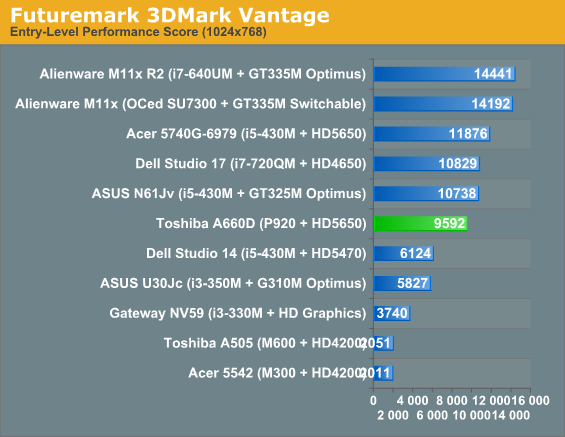
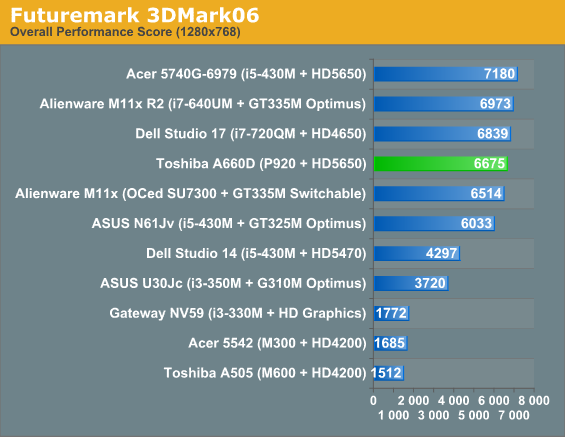
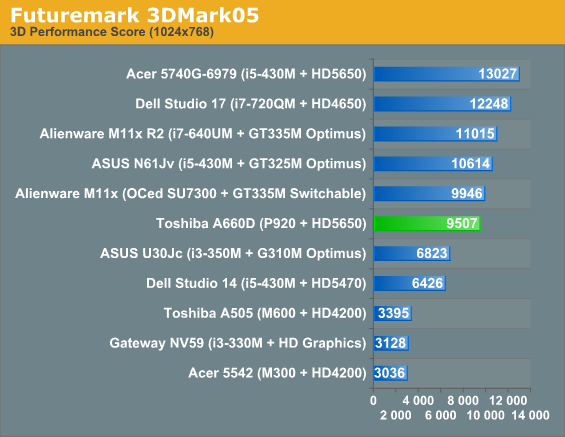

The only other HD 5650 system we've tested to date is the Acer 5740G (which is, sadly, discontinued—though you can get the 7740G if you don't mind the 17" chassis). As mentioned already, that 5650 was clocked at 550MHz compared to 450MHz in the A660D, plus it used an i5-430M CPU. The result is a performance lead of anywhere from 6% (3DMark06) to 36% (3DMark05) over the A660D, but what we don't know for sure is if the limiting factor is the CPU or the lower GPU clock. Most likely it's some of each, so let's look at actual gaming performance and see where the chips fall.










33 Comments
View All Comments
bennyg - Thursday, October 7, 2010 - link
This quad core simply has no logical benefit to it. Who buys a quad core for price and battery life (given Intel's penchant for monopolistic behaviour, if this was a market segment worth worrying about we'd have a dedicated mobile i7 quad die not harvested desktop Lynnfields)Even in benches where it's sposed to benefit from highly multithreaded workloads - e.g. cinebench multi - it's beaten by a i3. Why would AMD even bother releasing something this poor is beyond me.
AMD notebooks like this don't sell because they don't make sense.
The Crying Man - Tuesday, August 31, 2010 - link
Wow... $950 for this? Amazon's selling the dv6-3050us with the Phenom II N930 for $890 and even cheaper on Newegg - better processor, driver support from AMD, and the GPU has normal clocks. Toshiba must put a premium for an ExpressCard slot or their cheap looking designs... What kinds of stupid thoughts go through the minds of that company's decision makers?I think it's time AMD started making their own special edition laptops with configurations OEMs aren't willing to put together. Why can't we get a MR HD5870 + Phenom II X920 BE?
Roland00 - Tuesday, August 31, 2010 - link
That specific model has even been cheaper before. One week on newegg it was 779, and if you did a 50 MIR it was 729 AR. Another week Frys.com had a similar promotion where it was 799 and if you did a 50 MIR it was 749 AR.The Crying Man - Tuesday, August 31, 2010 - link
Yep, bought mine way back in July on Amazon when it was $775.blackshard - Tuesday, August 31, 2010 - link
Hello. Just a suggestion: check the battery wear level on this notebook (hwmonitor does it well). I just bought an Toshiba L650-10H with an AMD P520 (2.3 Ghz part) and HD5650. The video chip was clocked to 450 Mhz, as far as I remember. Anyway the 48Wh battery came with a silly 20% wear level, leaving around 39Wh for a brand new laptop. I don't know if it is a faulty battery or a "feature" coming straight from the factory, but it is enough for me to drop away toshiba notebooks.Also the display was the worst thing I've ever seen: the Windows 7 loading logo is exposing a really huge dithering problem with colors fading to black.
JarredWalton - Thursday, September 2, 2010 - link
HWMonitor reports the wear level as 2%, which probably came from me going through 10-12 recharge cycles during testing. Now, I wish I could say as much for another laptop I just got, where the wear level is reporting at 30%. :-\larson0699 - Tuesday, August 31, 2010 - link
I'm on an A665 at work, P920, 4GB, 500GB, 16", $799. We've had this for a while now. But whenever I'm in early or need to get online during break, this is the machine I use. Absolutely brilliant on Toshiba's part. It's a shame we don't also sell Sony...hgd - Tuesday, August 31, 2010 - link
<quote>On the other hand, AMD specs the P920 for 25W compared to 35W on the 720QM,
</quote>
Doesn't 720QM have 45W TDP?
JarredWalton - Tuesday, August 31, 2010 - link
Correct. Fixed.Cal123 - Tuesday, August 31, 2010 - link
Acer has a P520 with 5650 in a 15.6" for only $599, I'd really like to see a review of that. It looks good to me, if Acer put it together well. I don't think Acer screws up the graphics like Toshiba does.Aspire 5551G-4591
http://www.microcenter.com/single_product_results....